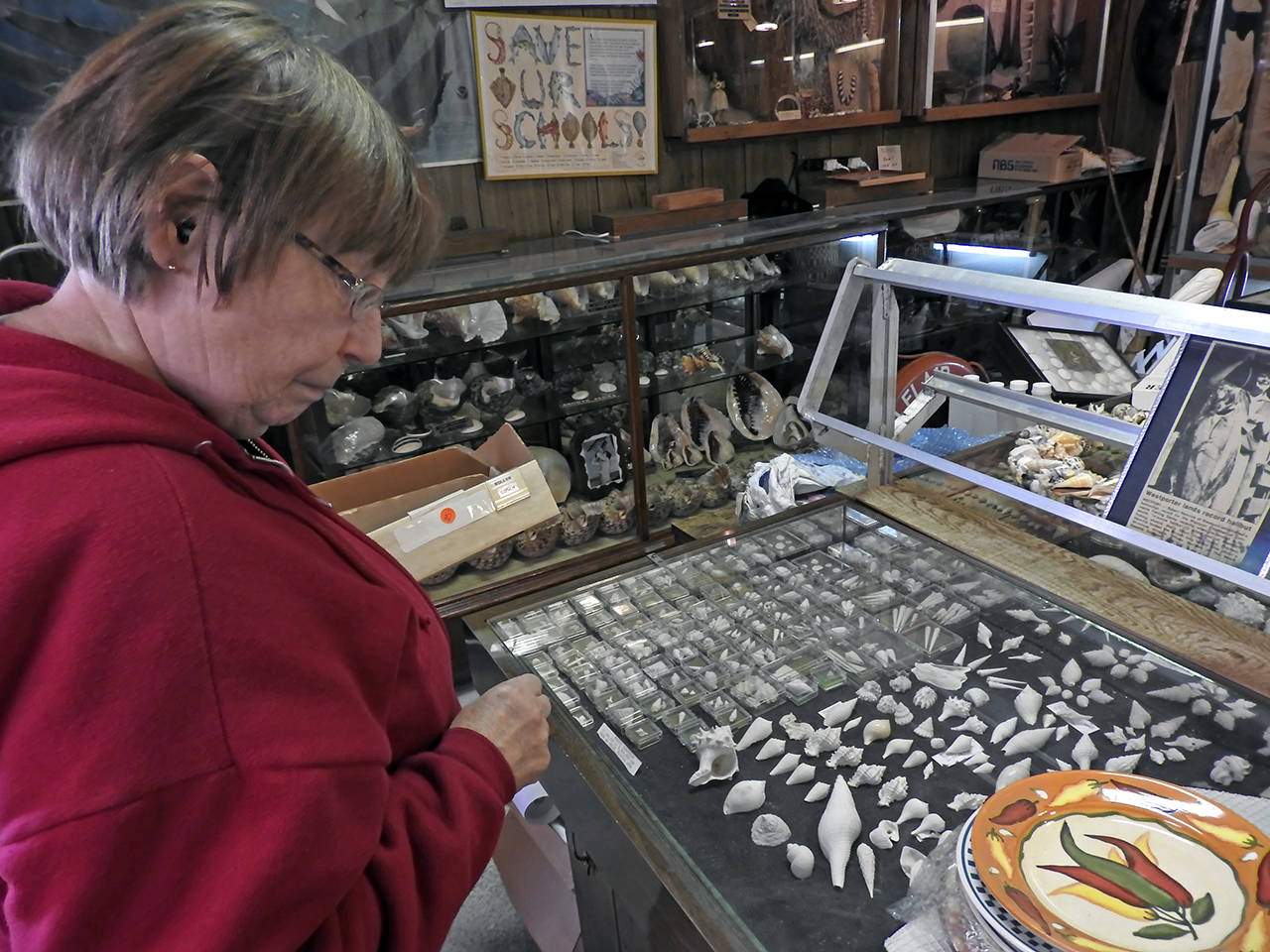By Kat Bryant
Grays Harbor News Group
After a third potential sale of Westport’s Shell Flair Museum fell through last week, the owner has decided to sell off its contents piece by piece.
Darlene Burke — daughter of the late Dorothy Harrison, who amassed the collection over her lifetime — is traveling from Snohomish next week to conduct the final sale. It will take place March 20-22 at Shell Flair, on the southeast corner of Forrest Street and Ocean Avenue.
This is something she’d hoped she would never have to do.
“I really don’t want to have to break it up,” she said in a 2018 interview, when the complete museum was put up for sale along with the attached gift shop, residential space and storage barn. “She worked too hard, put her whole heart into that, and I want to see it go to a good place as a unit.”
But with no takers for three years since her mother’s passing in April 2017, she now intends to liquidate the museum’s contents so she can sell the property unencumbered and settle the estate.
“We’re trying to let different groups and organizations and other interested parties know that this is, unfortunately, going to happen now,” said Alan Rammer, a longtime family friend who has been instrumental in helping Burke sort out the horde of artifacts left by Harrison — not just in the shop and museum, but also in endless stacks of boxes in the attic.
“Some of the specimens we unpacked were tagged from 1965. She was collecting this stuff before the dream of having this shop came through,” he said. “When we started going through these boxes in 2017, some of this stuff hadn’t seen the light of day in 52 years.”
Between all of that and the museum pieces, he said, “the best of the best” is now up for grabs.
Among the groups interested in this sale are Marsh’s Free Museum in Long Beach, the University of Washington, various shell collector clubs and the Westport-South Beach Historical Society (where Harrison served many years ago as founding director).
“I spent a couple years with Dorothy prior to her death, and we often discussed her hopes that the collection would stay in Westport as a collection. … A bit of Westport’s history is being lost,” said John Shaw, executive director of the Historical Society.
“A lot of (the museum display) comes from her collecting; a lot of it she has purchased from people; a lot of it has been donated to her by other people who knew she had a museum and that she would take care of the items that were given,” Burke said in 2018.
The centerpiece is a large display from Australia’s Great Barrier Reef, which takes up about a quarter of the museum space.
“(Harrison) purchased that from a man by the name of Ed Furlong, who was in the shell business and had a place in Hoodsport,” Burke said in 2018. “What’s in that display now, you will not be able to get again. There’s no shelling there, no nothing anymore because it’s protected. So there’s a lot of things in there that are one of a kind.”
Some of the museum’s treasures come from far inland.
“Some of the things were collected in Idaho (such as arrowheads and obsidian needles), and there were a lot of things from the ’30s and ’40s, the Depression — toys and other things that she kept,” Burke said in 2018. “She was a collector of all kinds of things.”
Also among the treasures to be found are 30 or 40 shells with Italian cameos carved into them.
“In the ’40s and ’50s, they took bullmouth helmet shells and carved women’s brooches and pins out of them for the very elegant women of the day, and then they’d cut them out (of the shell),” said Rammer. “These are actual cameos that haven’t been cut out of the shell yet. When you hold them up to the light, they’re exquisite.”
In the days preceding the sale, volunteers will shift all of the merchandise remaining in the gift shop into one area and mark it down for final sale, Rammer said. That includes numerous boxes and jars full of small shells and other bulk items, which might appeal to crafters for mosaics, collages.
Then, because the museum space is such a tight squeeze, they will pull several of the display cases out into the shop area for easier perusal.
“But for the big heavy things, we’re going to have to take people back three or four at a time,” said Rammer.
Most of the smaller museum displays will be sold as sets, with the case included, he said. “You’ll buy the crab case, or the shrimp case, or the sand dollar case, or the sea urchin case,” he said. Once the cash is paid, “we’ll mark it sold, then arrange for the party to pick it up.”
Other cases, such as the large display of “growth series” shells and the cabinet full of corals, will be broken up so that people can buy individual specimens.
Whatever’s left after Sunday will be sold through an auction house at a later date, Rammer said.
Sale hours are 10 a.m. to 5 p.m. Friday through Sunday, March 20-22, at 102 S. Forrest St.
Only cash will be accepted, and all sales will be final.
“This is not for the looky-loos,” Rammer emphasized. “This is for people with sincere intent to purchase.”


